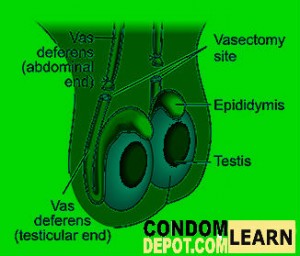Male contraception is a hot topic in male rights community, especially with Vasalgel being in the testing stages this year. But, until it’s approved, men still have less options when it comes to contraception than women do. For this reason, vasectomies continue to remain a popular choice with those who do not wish to have any (or any more) biological children.
Vasectomies and Unwanted Pregnancies

Costing between $350-$1000, vasectomies are permanent (usually noninvasive) outpatient surgical procedures which take 20 minutes or less to complete and are nearly 100% effective against unwanted pregnancy. Sounds great, right? It seems even better when you consider the upwards of the $6000 cost of a tubal sterilization for women, which also is very invasive and takes a long time to recover from.
Nonetheless, there are downsides to getting a vasectomy. For three months after the procedure, semen still comes out and mixes with the seminal fluid, as usual. Until it stops coming out, which must be confirmed by a doctor (because male ejaculate with not visually change in quantity or consistency once this occurs), pregnancy is still very possible.

Yet another potential hazard is this: 1 in 1000 vasectomies fail within the first four months, meaning that the vas deferens grows back and begins allowing sperm to mix with seminal fluid once again, instead of the sperm being reabsorbed into the body, as is the normal outcome. Just another reason to make sure you go to your follow-up doctor’s visit after the procedure is completed– just in case.
Another matter to consider is the possibility of temporary circumstances influencing you to get a vasectomy, such as unemployment, being single or a having health problem which seems bad now but which may fade away in time. Because reversal of a vasectomy and freezing sperm is not guaranteed to succeed, it is really is something you have to be completely ready for, both now and in the long term.
Vasectomies and STDs
And, of course, the main side effect for men who get vasectomies is a false sense of security when it comes to the other risks involved from unprotected sex. Not only is it still just as possible to contract an STD after a vasectomy, contrary to popular belief, STDs can still be easily transmitted through seminal fluid into a partner’s mouth, vagina or anus, even after a vasectomy, as they are transmitted through the seminal fluids, not through the sharing of sperm.
After a vasectomy, barriers such as male condoms, dental dams and female condoms are still necessary to protect yourself and your partner from STDs, and for the prevention of unwanted pregnancy for the first three months following the procedure. To learn more about STDs, check out our comprehensive STD Risk Assessment page.
The Multiple Methods Approach
When I feel safer, I feel sexier, and I always like to have a backup plan in case one method of contraception fails. As a female, this is why I use hormonal birth control pills and LifeStyles condoms. They aren’t for everyone, but it’s a winning combo that has worked splendidly for me thus far.
Vasectomies offer the same peace of mind for men, as birth control pills (and other means of contraception) do for women. It provides the ultimate assurance that they will not impregnate their partner during vaginal sex. But, continuing to use a condom, like the Kimono MAXX, as a backup plan and as a means of preventing the transmission of STDs, plus regular STD testing by a professional, are currently the very best ways for you and your partner to stay safer.
